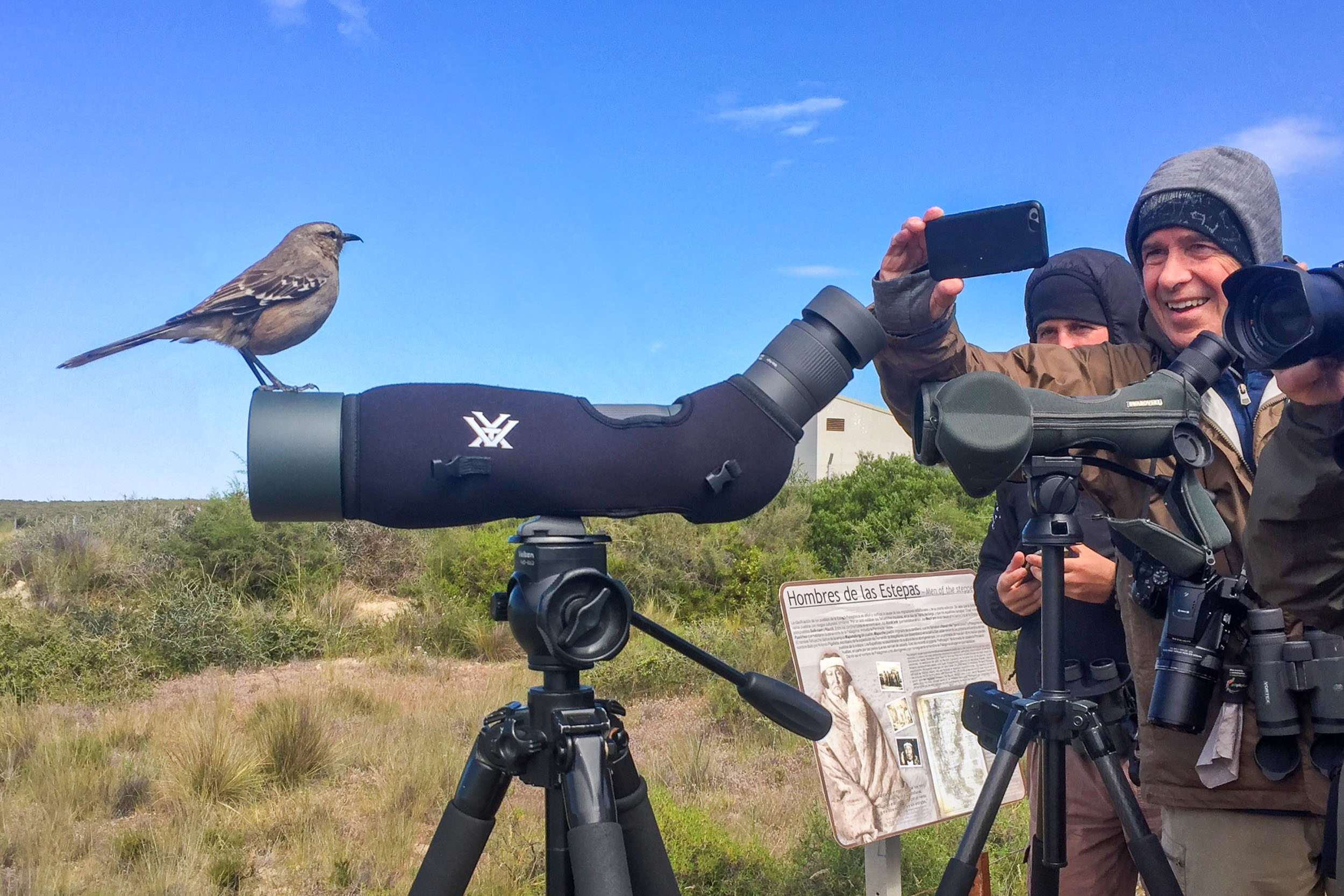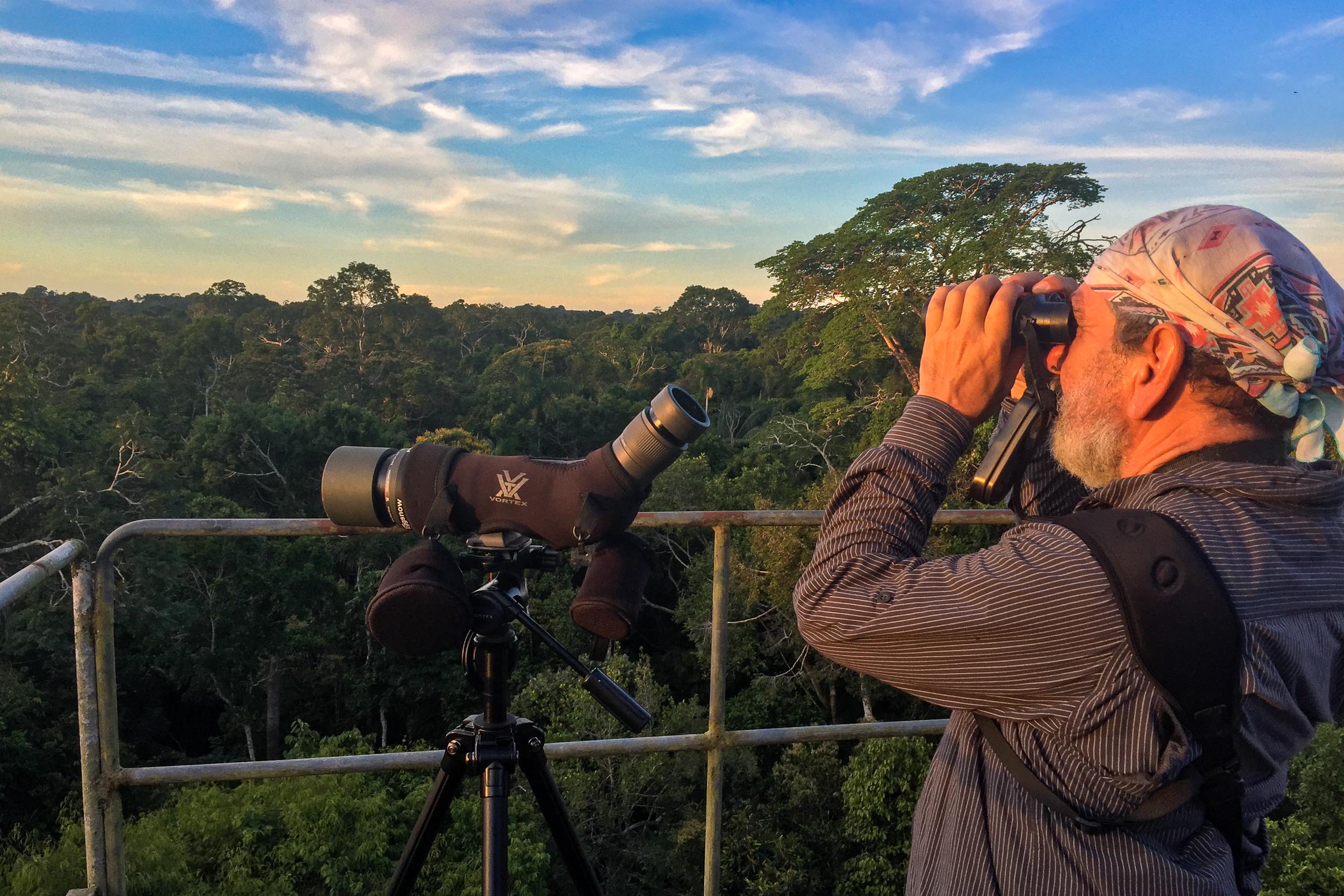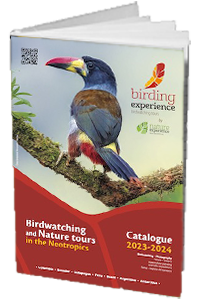Ornithological Journey in Argentina, November 6 to 21, 2019.
Guide: Xavier Amigo
Itinerary: Terra Australis
“Terra Australis”, one of our birdwatching trips, is a 14-day immersion in search of the most iconic species of the southern cone of America. Patagonia, during the austral spring, slowly comes alive. Days lengthen to about 15 hours of natural light, the weather warms to an average of 15°C during the day, allowing us to take part in this birdwatching trip to Argentina for extensive and rewarding observations of the region, during the courtship and breeding season for many species.
Itinerary
06/11 – Day 1: Bienvenidos a Argentina
07/11 – Day 2: The legendary Valdes Peninsula
08/11 – Day 3: Between orcas and giant petrels
09/11 – Day 4: Back inland
10/11 – Day 5: The largest continental colony of Magellanic penguins
11/11 – Day 6: Goodbye Valdes, hello Tierra del Fuego
12/11 – Day 7: The long-awaited Beagle Channel
13/11 – Day 8: Landscapes of the end of the world
14/11 – Day 9: Above the Beagle Channel
15/11 – Day 10: Deep Patagonia
16/11 – Day 11: Under the Patagonian winds
17/11 – Day 12: From steppes to sub-Andean forests
18/11 – Day 13: Under Patagonian rains
19/11 – Day 14: In search of rarities
20/11 – Day 15: The Perito Moreno glaciers
21/11 – Day 16: The pampas of Otamendi
06/11 – Day 1: Welcome to Argentina
Itinerary: Ezeiza Airport – Buenos Aires – Costanera del Sur

After a 10-hour flight, the plane lands on time at Ezeiza National Terminal. Despite ongoing airport renovations, the group manages to exit quickly. It’s such a joy to see everyone again! Most of the group already knows each other from previous trips to Colombia, Brazil, or Ecuador—a fantastic group of enthusiasts. This is going to be fun!
We board the bus, where Carlos, our driver for the northern part of the trip, is waiting. Off we go! It takes about 40 minutes to reach downtown Buenos Aires and the Puerto Madero district. Our hotel is strategically located, allowing us to quickly enjoy a small traditional restaurant to try some empanadas, a culinary specialty of the country.
After this delicious snack, Carlos quickly drops us off at the entrance of the Costanera del Sur reserve, where we’ll spend the rest of our first day as an introduction to Buenos Aires’ birdlife. It only takes seconds to start our list. Right at the entrance, Picazuro Pigeons (Patagioenas picazuro) greet us, accompanied by Eared Doves (Zenaida auriculata). A Southern Caracara (Caracara plancus) soars overhead, while a pair of Monk Parakeets (Myiopsitta monachus) guard the entrance gate.
Nearby, a pair of Southern Lapwings (Vanellus chilensis) make their characteristic shrill calls. Amid this, introduced species add to the soundscape: European Starlings (Sturnus vulgaris) and House Sparrows (Passer domesticus) are increasingly common in Argentina’s capital.
Along the trail, a few Guira Cuckoos (Guira guira) cross our path. Above them, the graceful and heavy flight of a Maguari Stork (Ciconia maguari) elicits awe from the group. This American stork captivates with its size and elegance.
It’s spring in the Southern Hemisphere, and many species are beginning to nest. Inside the dense forest, we spot the nest of a magnificent Rufescent Tiger-Heron (Tigrisoma lineatum). The trees are not yet fully covered in summer foliage, making it easier to spot birds on the branches. This helps us observe a Checkered Woodpecker (Veniliornis mixtus) as it puts on a show for the group. Nearby, a Narrow-billed Woodcreeper (Lepidocolaptes angustirostris) repeats the scene.
Around the flowering erythrina trees, Glittering-bellied Emeralds (Chlorostilbon lucidus) flutter about. This hummingbird is the most common in urban areas. The Rufous Hornero (Furnarius rufus), with its distinctive song, becomes a constant presence. A Small-billed Elaenia (Elaenia parvirostris) serenades us next, joined by Bran-colored Flycatchers (Myiophobus fasciatus). Masked Gnatcatchers (Polioptila dumicola) are abundant and approachable here.
Several warblers, like the Masked Yellowthroat (Geothlypis aequinoctialis) and Golden-crowned Warbler (Basileuterus culicivorus), are also seen along the trail. It leads us to lagoons teeming with aquatic species. The Whistling Heron (Syrigma sibilatrix) becomes a group favorite, competing with the Southern Screamer (Chauna torquata).
From various observation decks, we spend nearly 40 minutes scanning the water, which is vital for herons, ducks, and other waterfowl. The Most-spotted, White-tufted, and Great Grebes are among the highlights, alongside the Rosy-billed Pochard (Netta peposaca).
A total of 100 species in just one afternoon (4 hours) is an excellent start! A toast with Argentine wine during dinner marks this achievement and celebrates the group’s arrival in the land of gauchos.
07/11 – Day 2: The Legendary Valdes Peninsula
Itinerary: Buenos Aires – Trelew – Puerto Madryn – Isla Pajaro – Puerto Piramides
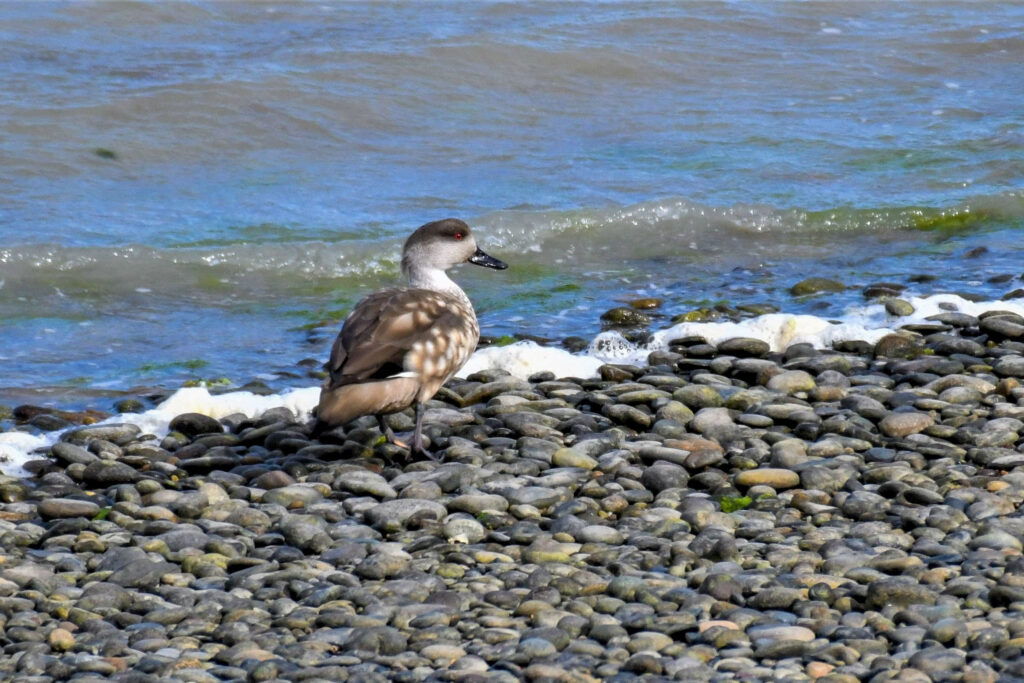
Today marks the beginning of our exploration of Patagonia. Yesterday’s observations around the capital were just an appetizer. Our flight to Trelew departs on time, and two hours later, we arrive in the Chubut region. Our local guide, Karina, is waiting at the airport with our excellent driver, Ruben. We set off for our first immersion into the diverse ecosystems of northern Patagonia.
Our first stop is at the Valdes Peninsula National Park checkpoint, where we pay the entrance fee for this conservation area. Here, we encounter our first Elegant Crested Tinamou (Eudromia elegans), a species we’ll see daily in the coming days.
At Isla Pajaro (Bird Island), we set up our scopes to scan the shoreline. Despite high tide, several Patagonian species make their appearance, including Crested Duck (Lophonetta specularioides), Chilean Flamingo (Phoenicopterus chilensis), Blackish Oystercatcher (Haematopus ater), Brown-hooded Gull (Chroicocephalus maculipennis), and the ever-present Kelp Gull (Larus dominicanus).
By 6:00 PM, we arrive in Puerto Piramides and quickly board a large zodiac for an unforgettable experience. This afternoon’s target isn’t a bird but the Southern Right Whale (Eubalaena australis). Nature delivers an extraordinary show, with at least 12 different individuals displaying remarkable activity.
On the return trip, we spot a few uniquely Patagonian bird species, including the curious Snowy Sheathbill (Chionis albus), the elegant Dolphin Gull (Leucophaeus scoresbii), and the Royal Tern (Thalasseus maximus). Back in Puerto Piramides, we enjoy a well-deserved local wine and a hearty meal before retiring to recharge for tomorrow’s adventures.
08/11 – Day 3: Between Orcas and Giant Petrels
Itinerary: Puerto Piramides – Punta Delgada – Punta Cantor

This morning, we start early with a walk around the village of Puerto Piramides. The path takes us to the heights overlooking the bay, where the windswept shrub-steppe vegetation reveals a wealth of birdlife. We find the Burrowing Owl (Athene cunicularia), Common Miner (Geositta cunicularia), Plain-mantled Tit-Spinetail (Leptasthenura aegithaloides), the elusive Short-billed Canastero (Asthenes baeri), the endemic Patagonian Canastero (Asthenes patagonica), and the robust Black-billed Shrike-Tyrant (Agriornis montanus).
After breakfast, we take a gravel road accompanied by the graceful flight of Southern Martins (Progne modesta). Along the dusty route, a family of Maras (Patagonian hares) cautiously surveys their surroundings. A quick-footed armadillo crosses the road and disappears into its burrow.
Patagonia’s subtle variations in vegetation types become evident. Ecotones between steppe and shrubland are the richest in the area, featuring hardy grasses and low plants shaped by strong, constant winds. A juvenile Variable Hawk (Geranoaetus polyosoma) perches on a roadside billboard, possibly using it as a substitute for trees in this treeless landscape. Nearby, a family group of Darwin’s Rheas (Rhea pennata) grazes peacefully, seemingly unfazed by our presence.
We stop at Punta Cantor for lunch. The restaurant owner informs us that orcas are present daily, and we’ve timed our visit perfectly with high tide, the best opportunity to see these iconic animals. The season is favorable, and we are extraordinarily fortunate: no fewer than 20 individuals pass before our eyes throughout the afternoon. Some inexperienced juveniles even attempt hunting sea lions, thrilling the group and fulfilling lifelong dreams for many.
From the cliffs, we observe a large number of Giant Petrels. With excellent photographs, we identify both species: the Northern (Macronectes halli) and Southern Giant Petrels (Macronectes giganteus). Juveniles of each species differ slightly in plumage, and the tip of their beaks shows distinct coloration.
We return to our hotel in the late afternoon, exhilarated by the day’s extraordinary sightings.
09/11 – Day 4: Back Inland
Itinerary: Punta Piramide – Cota 130 – Laguna Ornitólogo

As we leave the Valdes Peninsula, our first stop is the National Park Interpretation Center for some final birdwatching in the area. Here, we spot our first Band-tailed Earthcreeper (Ochetorhynchus phoenicurus). A Harris’s Hawk (Parabuteo unicinctus) soars nearby, followed shortly by a Peregrine Falcon (Falco peregrinus) cutting through the air above us. We also hear a Darwin’s Tinamou (Nothura darwinii) calling close by.
On the way to Puerto Madryn, our driver points out a group of Burrowing Parakeets (Cyanoliseus patagonus) feeding on the ground on Schinus johnstonii berries. We take some time to observe and photograph these unique parrots. The rest of the morning is dedicated to searching for the rare and localized Carbonated Sierra-Finch (Phrygilus carbonarius), which we find near a nesting site of the White-throated Cacholote (Pseudoseisura gutturalis). We also spot a single Greater Wagtail-Tyrant (Stigmatura budytoides) and the more common Common Diuca-Finch (Diuca diuca).
Our journey continues to Laguna Ornitólogo, an unconventional but highly productive birding site. This lagoon, a wastewater recovery area near Trelew, is remarkably rich in species. The immaculate Coscoroba Swan (Coscoroba coscoroba) is omnipresent, along with over 20,000 Red Shovelers (Spatula platalea). Among the rarer sightings, we note Spectacled Ducks (Speculanas specularis), Ringed Teals (Callonetta leucophrys), a Brazilian Teal (Amazonetta brasiliensis), and Cinnamon Teals (Spatula cyanoptera).
Rosy-billed Pochards (Netta peposaca), Lake Ducks (Oxyura vittata), Pied-billed Grebes (Podilymbus podiceps), and three species of coots are abundant. Black-necked Stilts (Himantopus mexicanus) are also present, concealing rarer individuals like Wilson’s Phalaropes (Phalaropus tricolor) and Sanderlings (Calidris alba), both migratory species. Across the lagoon, we spot a few Gray-hooded Gulls (Chroicocephalus cirrocephalus) resting on the shore. Another exceptional day of birding!
10/11 – Day 5: The Largest Continental Colony of Magellanic Penguins
Itinerary: Trelew – Punta Tombo – Rawson

As usual, we have an early breakfast, as it’s a 1.5-hour drive to Punta Tombo, home to one of the largest known colonies of Magellanic Penguins (Spheniscus magellanicus). Approximately 230,000 individuals inhabit over 210 hectares of land here.
On the way, brief stops along the dirt road reveal some new species. Numerous White-winged Black-Tyrants (Knipolegus aterrimus) hunt among the Colliguaja integerrima bushes. A White-tipped Plantcutter (Phytotoma rutila) sings from the top of an Algarobo tree (Prosopis alpataco).
Upon reaching the reserve, the first penguin nests come into view as we step off the bus. Nesting began 1-2 months ago, but the first chicks (“pinguinitos”) have yet to hatch. The well-maintained trail leads us through a field of burrows. Along the way, we encounter an Elegant Crested-Tinamou (Eudromia elegans) strolling among the stoic penguins. Two White-winged Mockingbirds (Mimus triurus) flash their characteristic white wing patches as they fly by. Patagonian Yellow-Finches (Sicalis lebruni) add color to the scene.
At the bay’s viewpoints, we spot the endemic White-headed Steamer-Duck (Tachyeres leucocephalus), restricted to the Chubut coastline and currently nesting. Only males are visible, as the females remain at the nest sites hidden beneath coastal shrubs. Among the coastal rocks, a pair of Crested Ducks (Lophonetta specularioides) forage for marine larvae and invertebrates. Dolphin Gulls (Leucophaeus scoresbii) join the activity, along with a juvenile Olrog’s Gull (Larus atlanticus), blending in with the more common Kelp Gulls (Larus dominicanus).
On the return walk, familiar species like the noisy House Wren (Troglodytes aedon) brighten the trek. At the park rangers’ cabin, a pair of Brown Skuas (Stercorarius antarcticus) appear to be scouting for their next meal. Several Guanacos (Lama guanicoe) watch us warily from a distance.
After a delicious buffet lunch at Estancia La Perla, we head north through the Patagonian steppes toward Rawson. Here, we embark on a boat excursion. Donning life jackets, our semi-rigid zodiac takes us along the Chubut River toward the Atlantic Ocean. Along the riverbanks, two Patagonian Oystercatchers (Haematopus leucopodus) probe the sand. Despite challenging weather, we are lucky to spot a few Commerson’s Dolphins (Cephalorhynchus commersonii), a small cetacean endemic to Argentine waters, often seen from Puerto Rawson.
11/11 – Day 6: Goodbye Valdes, Hello Tierra del Fuego
Itinerary: Chiquichana Lagoon – Trelew Airport – Ushuaia – Bahía Encerrada Urban Reserve
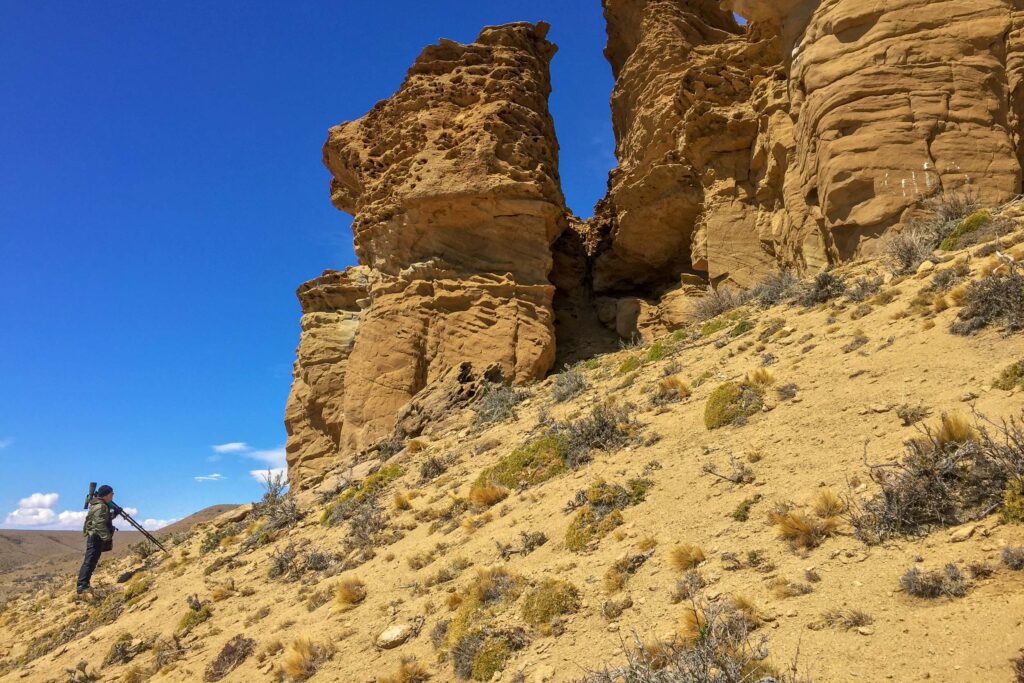
In the heart of Trelew lies Chiquichana Lagoon, a crucial water body for aquatic species in the area. We take advantage of a few hours before our flight to Tierra del Fuego to add to our bird list. The morning light provides excellent opportunities to photograph the Chiloé Wigeon (Mareca sibilatrix) and White-tufted Grebe (Rollandia rolland), while a group of Black-faced Ibis (Theristicus melanopis) flies overhead.
We linger by the reeds to spot a Wren-like Rushbird (Phleocryptes melanops) and the stunning Many-colored Rush-Tyrant (Tachuris rubrigastra). Among the terrestrial species, we make our first observations of the noisy Austral Thrush (Turdus falcklandii) and the Picui Ground-Dove (Columbina picui).
Our bus takes us to Trelew Airport, and after checking in, we explore the area around the airport, finding a Grassland Yellow-Finch (Sicalis luteola) and several Mourning Sierra-Finches (Phrygilus fruticeti). After a two-hour flight, we land in Ushuaia, the southernmost city in South America.
Excited to begin birding in this new region, we head to the small Bahía Encerrada Urban Reserve. This 30-hectare site lies between Ushuaia and the Beagle Channel, framed by the Andes. A South American Snipe (Gallinago paraguaiae) calls as it lands close to us. The ubiquitous Magellanic Goose (Chloephaga picta) is a delight for the group. A Correndera Pipit (Anthus correndera) performs its display nearby, and we make our first sighting of the common Black-chinned Siskin (Spinus barbatus).
Before dinner, we observe a Dark-bellied Cinclodes (Cinclodes patagonicus) and a large number of Chilean Swallows (Tachycineta meyeni) in flight.
12/11 – Day 7: The Long-awaited Beagle Channel
Itinerary: Beagle Channel – Harberton Ranch – Ushuaia

A relaxed morning begins at 9:00 AM from the port of Ushuaia. We secure nearly the entire upper deck of the catamaran, offering unbeatable views of the Beagle Channel and excellent opportunities to spot pelagic and semi-pelagic species.
Shortly after departure, we begin our sightings: Chilean Skuas (Stercorarius chilensis), Black-browed Albatrosses (Thalassarche melanophris), and Southern Giant Petrels (Macronectes giganteus) accompany us throughout the journey.
Our first stop is around Alicia Island, where we observe an active colony of Imperial Cormorants (Leucocarbo atriceps). Nearby, on the rocky islets surrounding the lighthouse, we see a group of South American Sea Lions (Otaria flavescens). A Blackish Cinclodes (Cinclodes antarcticus) makes a brief appearance, delighting most of the group. Those who missed it see another individual near the lighthouse, drinking fresh water trickling down the captain’s windshield—an unusual behavior.
At Mackinlay Pass, we are lucky to spot the rare Magellanic Diving-Petrel (Pelecanoides magellani). The colonies of two penguin species are also highlights. Around 45 Gentoo Penguins (Pygoscelis papua) nest here cyclically, while the more numerous Magellanic Penguins (Spheniscus magellanicus) spread across the small island. Among this mixed colony, several pairs of Kelp Geese (Chloephaga hybrida) continue their courtship displays. Around them, Austral Negritos (Lessonia rufa) dart, and a South American Tern (Sterna hirundinacea) demonstrates its fishing prowess.
We disembark at Harberton Ranch for a delightful lunch in a historic setting. After coffee, we resume our quest for austral species. At Bahía Brown, we witness the impact of an invasive beaver colony introduced in the 1940s. Here, we spot the Patagonian Sierra-Finch (Phrygilus patagonicus) and the energetic Thorn-tailed Rayadito (Aphrastura spinicauda).
Our final stop at Laguna Victoria offers a memorable sighting: the impressive Magellanic Woodpecker (Campephilus magellanicus). We also see several pairs of Ashy-headed Geese (Chloephaga poliocephala) and a single pair of the rare Flying Steamer-Duck (Tachyeres patachonicus).
On the drive back to Ushuaia, we revisit some species previously observed. To end the day, we enjoy our first Patagonian lamb roast. Buen provecho!
13/11 – Day 8: Scenery at the End of the World
Itinerary: Tierra del Fuego National Park – Bahía Lapataia – La Ensenada
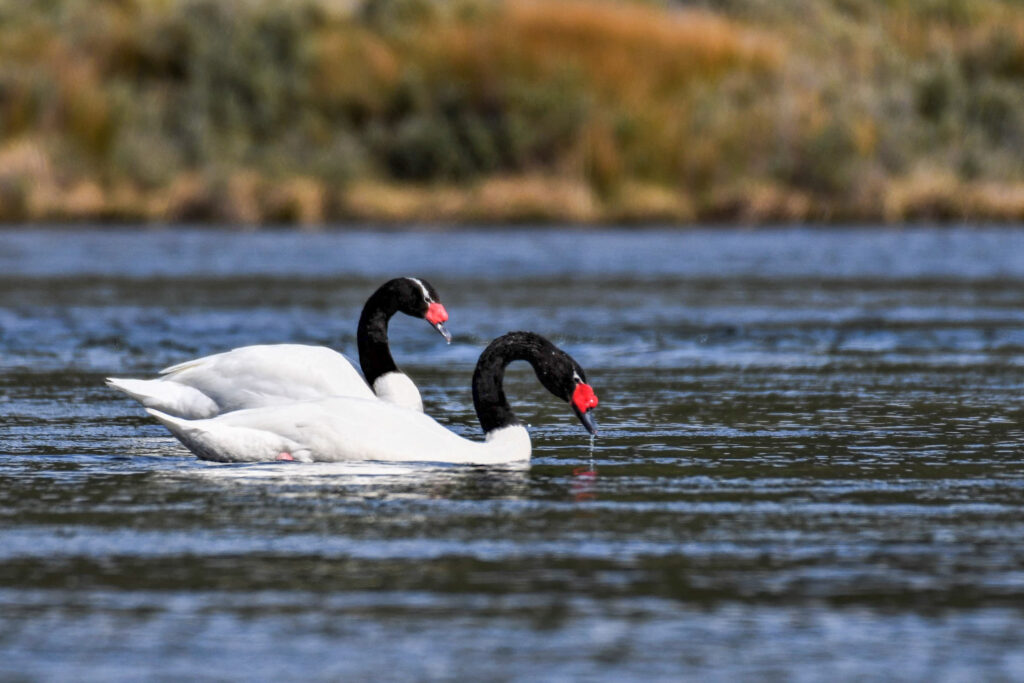
Tierra del Fuego National Park is composed almost entirely of Andean-Patagonian forests, dominated by Lenga Beech (Nothofagus pumilio). We explore a small fraction of the 2,000 hectares open to the public within this 63,000-hectare state reserve. Nestled between the Sierra de Inju Gooyin and the Beagle Channel, the trails lead us to breathtaking landscapes—mountainous, lacustrine, and coastal.
At Bahía Lapataia, a Patagonian fjord on the main island of Tierra del Fuego, we observe White-rumped Sandpipers (Calidris fuscicollis), Magellanic Oystercatchers (Haematopus leucopodus), and the common Black-crowned Night-Heron (Nycticorax nycticorax). Against the backdrop of Cerro Vinciguerra, we spot our first Andean Condors (Vultur gryphus).
Above the sub-Antarctic Magellanic forests, a Chilean Hawk (Accipiter chilensis) appears. This species, with its controversial taxonomy, is often regarded as a subspecies of the Bicolored Hawk—a puzzle of modern taxonomy.
Within the same forests, we both hear and see the tiny but territorial Austral Pygmy-Owl (Glaucidium nanum). A pair of Magellanic Woodpeckers (Campephilus magellanicus) drills into dead Southern Beech (Nothofagus antarctica). The distinct song of the Magellanic Tapaculo (Scytalopus magellanicus) echoes through the woods, though the elusive bird remains hidden today.
In contrast, the frenzied and delicate White-throated Treerunner (Pygarrhichas albogularis) is abundant and approachable, offering excellent photo opportunities, as do the Tufted Tit-Tyrant (Anairetes parulus) and White-crested Elaenia (Elaenia albiceps). Along marshy vegetation, the characteristic song of the Short-billed Wren (Troglodytes aedon) catches our attention.
We conclude the afternoon with sightings of the Austral Blackbird (Curaeus curaeus), leaving the serene ambiance of the eastern Fuegian Andes to return to our hotel.
14/11 – Day 9: Above the Beagle Channel
Itinerary: Martial Glacier National Park – Ushuaia Landfill

The Martial Glacier is part of the mountain range overlooking Ushuaia, offering magnificent landscapes and an unparalleled view of the Beagle Channel. The peak reaches around 1,300 meters, but with the group, we ascend only to the lower nival zone at about 800 meters.
After a long climb through the glacial cirque, the snow crunches beneath our feet. This winter’s heavy precipitation has replenished the snow and water reserves critical to Ushuaia’s water supply. At the edge of the scree, wind and clouds greet us on our first day of unsettled weather.
Despite the conditions, a surprise awaits us at the 600-meter plateau: a silent Austral Pygmy-Owl (Glaucidium nanum) hidden in dense, stunted lenga shrubs—an unusual altitude for this tiny diurnal owl. Higher up, we spot Ochre-naped Ground-Tyrants (Muscisaxicola flavinucha) and Dark-faced Ground-Tyrants (Muscisaxicola maclovianus).
We search unsuccessfully for the Gray-breasted Seedsnipe (Thinocorus orbignyianus) in the high-altitude wetlands. On the descent, a Chilean Hawk (Accipiter chilensis) makes another brief appearance.
To end the day, we visit Ushuaia’s municipal landfill. Situated between the sea and the mountains, this site attracts a mix of coastal and highland species. Here, we have excellent sightings of the White-throated Caracara (Phalcoboenus albogularis) and several adult and juvenile Black-chested Buzzard-Eagles (Geranoaetus melanoleucus), alongside more common caracaras.
A final stop along the bay of Ushuaia wraps up this rich chapter of our journey. At 7:00 PM, our flight departs uneventfully for El Calafate, our next birding destination—but that’s another story…
15/11 – Day 10: Deep Patagonia
Itinerary: El Calafate – Laguna Tonchi – La Angostura
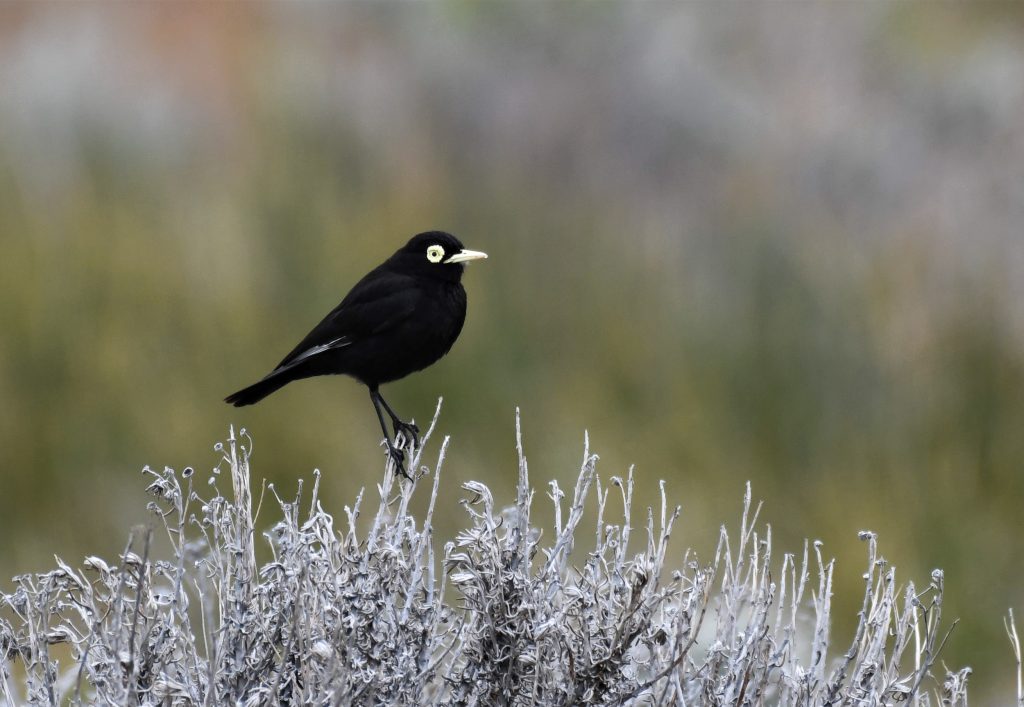
Today, we have a long journey to our next destination, starting at 5:30 AM, heading towards the Strobel plateaus. Distances in Patagonia are vast—crossing the steppes from one town to another can take hours, often without encountering a soul.
After two hours of driving, a brief technical stop allows us to add three new species to our list. A pair of Tawny-throated Dotterels (Oreopholus ruficollis) crosses the road ahead of the bus. Our driver, Julio, quickly stops, and we rush out to observe this long-anticipated species. Behind the gas station where we’ve stopped, a pair of Gray-hooded Sierra-Finches (Phrygilus gayi) feeds on seeds, while a proud Least Seedsnipe (Thinocorus rumicivorus) perches on a Lepidophyllum. The wind carries the calls of a Scale-throated Earthcreeper (Upucerthia dumetaria) and a Plain-mantled Tit-Spinetail (Leptasthenura aegithaloides). After a quick coffee, we resume our journey north along Route 40. Large groups of Baird’s Sandpipers (Calidris bairdii) forage on the seeds of coirón grass.
After a quick picnic lunch, we continue. Despite an extensive scan with the telescope around Laguna Tonchi, we’re unable to spot the elusive Hooded Grebe (Podiceps gallardoi). Nevertheless, we enjoy excellent views of Silvery Grebes (Podiceps occipitalis) and about a dozen previously seen species.
The return to Estancia La Angostura is leisurely, with a final stop along the Río Chico for some photos of Chiloe Wigeons (Mareca sibilatrix), Chilean Flamingos (Phoenicopterus chilensis), and an astonishing male Spectacled Tyrant (Hymenops perspicillatus). Upon arrival, we’re welcomed by the aroma of lamb roasting in the hearth, ready for dinner. It will be accompanied by Argentinian chorizo, guanaco ham, and grilled vegetables—a true Patagonian delight! Before dinner, we attend a short presentation on the Hooded Grebe.
16/11 – Day 11: Under the Patagonian Winds
Itinerary: La Angostura – Laguna Tonchi – Lago Cardiel – Santa Thelma

Before breakfast, we take a quick outing along the reed-covered islets of the Río Chico in search of the elusive Austral Rail (Rallus antarcticus). Despite our efforts, this secretive bird remains out of sight. The wind starts to pick up, and the forecast is not in our favor, predicting gusts of over 14 km/h.
After breakfast, we return to Laguna Tonchi. Unfortunately, once again, there’s no sign of the Hooded Grebe. Large flocks of Baird’s Sandpipers scour the shoreline, dodging the waves. Back at La Angostura, we decide to make a second attempt at the same site later in the morning. Interestingly, the distribution of other species observed earlier has shifted significantly, but the Hooded Grebe remains absent.
Our final hope is Lago Cardiel. Upon arrival, the predicted winds have arrived, lifting sand into the air and making it difficult to proceed. The lake is choppy, and we decide to abandon the exploration. The Hooded Grebe will not make it onto our list this time.
The glaciers of the eastern Andes are retreating, as are glaciers worldwide. Annual rainfall is steadily decreasing, partly due to advancing desertification and climate change. Lagoons are drying up, and conditions are no longer suitable for this rare and endemic bird.
We continue our journey to our next hotel, where we’ll spend the night.
17/11 – Day 12: From Steppes to Sub-Andean Forests
Itinerary: Santa Telma – Ruta 40 – El Chaltén
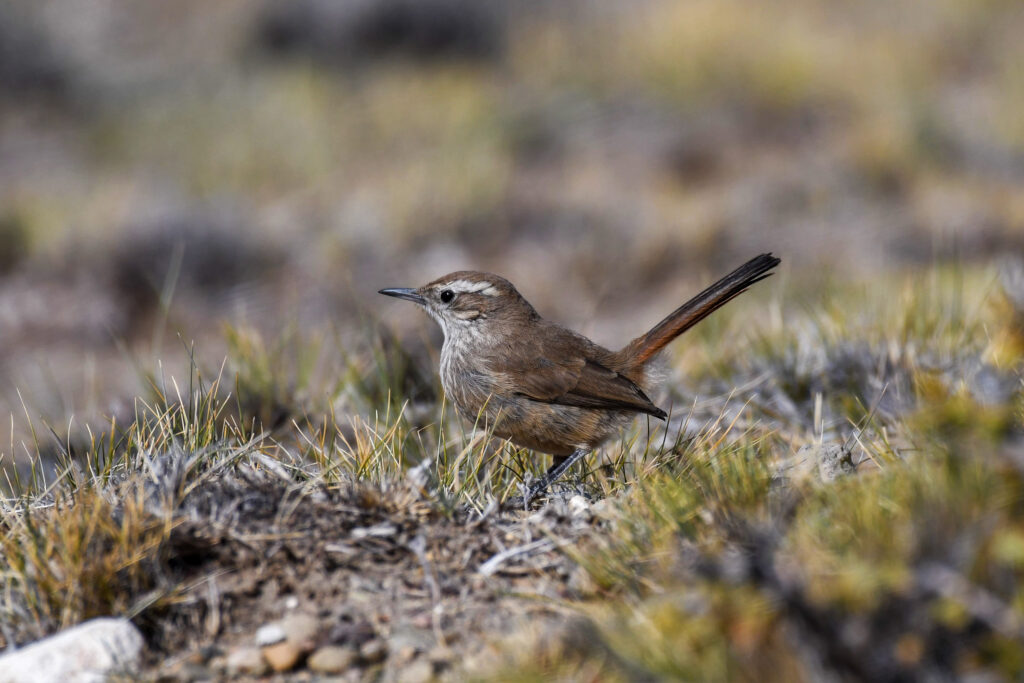
Before breakfast, a short walk through the rocky slopes of the property allows us to spot some Band-tailed Earthcreepers and Great Shrike-Tyrants. Early in the morning, a discussion about areas of rock outcroppings leads us to observe several Cinnamon-vented Ground-Tyrants (Muscisaxicola capistratus).
The long road to El Chaltén passes through picturesque Patagonian steppe landscapes. About 40 kilometers in, an armadillo crosses our path, prompting a leg-stretching break. During this stop, we spot several new species: Patagonian Yellow-Finch (Sicalis lebruni), Band-tailed Earthcreeper, and even a White-crested Elaenia (Elaenia albiceps), a species slightly out of its usual habitat. A well-placed rhea along the roadside gives photographers an excellent opportunity to capture this towering bird. Further along, a Gray Fox catches our attention as it hunts near a family of Least Seedsnipes (Thinocorus rumicivorus).
The over 5,000 km of Route 40 connect the Bolivian-Argentine border to the Strait of Magellan. This longest road in the country brings us to the small village of El Chaltén by late afternoon. We settle in quickly, and, right outside our hotel, the first Andean Condors treat us to their aerial displays.
18/11 – Day 13: Under Patagonian Rain
Itinerary: El Chaltén – Laguna El Cóndor – Ruta 23 – Mirador del Cóndor
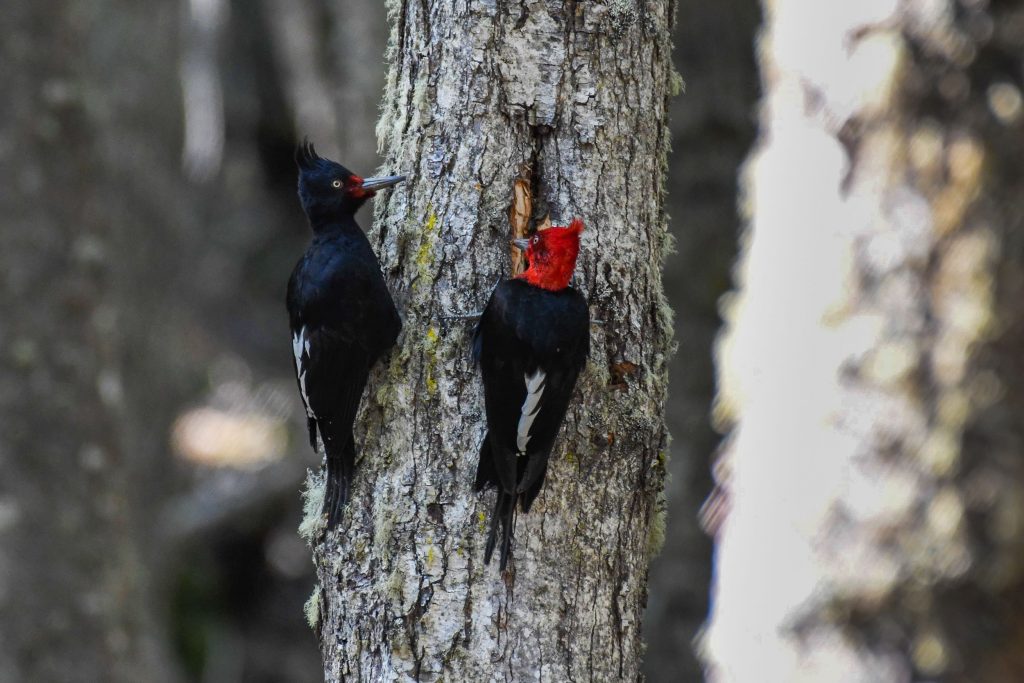
The quaint village of El Chaltén serves as the starting point for excursions to various areas of interest in Los Glaciares National Park. This expansive park, covering over 535,000 hectares, straddles the Chilean border and is home to the iconic Mount Fitz Roy and Cerro Torre. The usual panorama is breathtaking, but this week’s weather is not in our favor. Constant rain and strong winds (up to 90 km/h) will accompany us for the next two days—unusual for this time of year, according to locals.
Braving the rain, we head to Laguna El Cóndor. Just a few meters from the hotel, a pair of White-browed Ground-Tyrants (Muscisaxicola albilora) wander calmly, foraging for food. Entering the forest, we spot a pair of Magellanic Woodpeckers (Campephilus magellanicus) examining the trunks of Lengas (Southern Beech). Further along, on a small lake, a pair of Spectacled Teals (Speculanas specularis) pose stoically for photographs. A fleeting appearance by a Magellanic Tyrant (Agriornis montanus) in the foliage offers a glimpse of a bird we hope to observe more closely later.
These forested areas are also ideal habitats for Ashy-headed Geese (Chloephaga poliocephala), which we successfully spot. With the rain intensifying, we retreat to the bus that had been following us closely.
In the afternoon, we cross the bridge over the Las Vueltas River to explore the base of the condor cliffs. Several individuals soar above, eventually landing on the cliff tops. Nearby, a Chilean Flicker (Colaptes pitius) vocalizes and puts on quite a show. Thorn-tailed Rayaditos (Aphrastura spinicauda) are also observed in the area.
Later, we visit the Condor Viewpoint, where a flock of Austral Parakeets (Enicognathus ferrugineus) is preparing to roost. Higher up, a pair of Plumbeous Sierra-Finches (Phrygilus unicolor) sing their evening song.
Despite the relentless rain, a small group decides to venture out after dinner in search of the Rufous-legged Owl (Strix rufipes). After a brief playback, one individual crosses the beam of our flashlight. Satisfied with this sighting, it’s finally time to rest.
19/11 – Day 14: In Search of Rare Birds
Itinerary: El Chaltén – Chorillo del Salto – El Calafate – Laguna Nimez – Lago Argentino

A long drive awaits us this morning as we head to El Calafate to explore the Laguna Nimez and Lago Argentino. Upon arriving in El Calafate, we drop off our luggage at the hotel, freshen up, and quickly head out to the trails of Laguna Nimez, located just below our hotel. Our first stop is at a small lagoon nestled between the two larger bodies of water.
A quick scan of the shore reveals the rare Magellanic Plover (Pluvianellus socialis). With fewer than 2,000 individuals across Argentina and Chile, this sighting of two individuals is a highlight for everyone.
After lunch, we take the trail through the municipal reserve at Nimez, dedicating the afternoon to photography. The close proximity to species in this reserve offers exceptional observation opportunities. One unusual record is a Common Gallinule (Gallinula galeata), seen outside its typical range. Other highlights include Silver Teal (Spatula versicolor), Black-headed Duck (Heteronetta atricapilla), and, from a hide overlooking the lagoon, a territorial Plumbeous Rail (Pardirallus sanguinolentus), which boldly poses for five minutes.
Over the reedbeds, numerous Cinereous Harriers hunt alongside Chimango Caracaras (Milvago chimango). In the scrubby areas beyond, Sharp-billed Canasteros (Asthenes pyrrholeuca) are nesting. A few Barn Swallows (Hirundo rustica) have also arrived and will spend the boreal winter here. Identifying two pipit species, Correndera Pipit (Anthus correndera) and Hellmayr’s Pipit (Anthus hellmayri), proves challenging due to their subtle differences when not vocalizing.
20/11 – Day 15: The Glaciers of Perito Moreno
Itinerary: El Calafate – Perito Moreno National Park – El Calafate – Buenos Aires – Campana

Though this day was planned as a more relaxed, exploratory part of the trip, we couldn’t resist some birding—it’s our last day in Patagonia, after all!
Our first stop along the shores of Lago Argentino provides an excellent view of the elegant Two-banded Plover (Charadrius falklandicus). Further along, a group of seven adult Andean Condors (Vultur gryphus) watches over a cow carcass they’ve clearly been feasting on.
We then head northwest to discover the renowned Perito Moreno Glacier and its national park, the largest and oldest in the country. The first sight of this immense expanse of ice is awe-inspiring. While soaking in the view, a Rufous-tailed Plantcutter (Phytotoma rara) makes an appearance, completing our sightings of the two species in this fascinating genus in Argentina.
At the parking area, we search for and finally spot the elusive Grey-flanked Cinclodes (Cinclodes oustaleti), ticking off the last species we were missing. Along the walkways that reveal the glacial river, we revisit some species observed the previous day.
The forest canopy here is unusually tall, and the undergrowth is exceptionally well-preserved or restored in some areas. This habitat is ideal for two special local species: the Patagonian Tyrant (Colorhamphus parvirostris) and the Magellanic Tapaculo (Scytalopus magellanicus), both of which we successfully observe.
It is bittersweet to bid farewell to this magnificent and welcoming southern land. We head to the airport for our flight to Buenos Aires, where we will stay overnight in a hotel in Campana, close to our final birding site for tomorrow.
21/11 – Day 16: The Pampas of Otamendi
Itinerary: Campana – Otamendi – Ceibas – Buenos Aires

We depart at 6:00 AM for the Otamendi Reserve. The dirt trail along the river alternates between grassy expanses and shaded forests. In the open areas, several Southern Screamers (Chauna torquata) go about their activities, while the omnipresent song of the Rufous-browed Peppershrike (Cyclarhis gujanensis) adds a soothing backdrop to the morning. Wattled Jacanas (Jacana jacana) are abundant, and an Upland Sandpiper (Bartramia longicauda) soars overhead.
Large flocks of White-faced Ibises (Plegadis chihi) and Bare-faced Ibises (Phimosus infuscatus) move in formation. Our gaze remains fixed on the sky when a White-tailed Kite (Elanus leucurus) suddenly appears in view. The most common raptor here, however, is the Long-winged Harrier (Circus buffoni).
Before entering more wooded areas, we spot the subdued Brown-and-yellow Marshbird (Pseudoleistes virescens), the elusive Long-tailed Reed Finch (Donacospiza albifrons), the stunning Scarlet-headed Blackbird (Amblyramphus holosericeus), and the dimorphic Double-collared Seedeater (Sporophila caerulescens). Closer to the riverbank, typical species like the Dark-billed Cuckoo (Coccyzus melacoryphus), the Gilded Hummingbird (Hylocharis chrysura), and a Roseate Spoonbill (Platalea ajaja) taking flight captivate us.
In denser vegetation, several Solitary Black Caciques (Cacicus solitarius) vocalize loudly. We also spot the tiny and rare White-barred Piculet (Picumnus cirratus), along with two other characteristic woodpeckers of the area: the elegant White Woodpecker (Melanerpes candidus) and the Green-barred Woodpecker (Colaptes melanochloros). Another interesting riverside species is the Sooty Tyrannulet (Serpophaga nigricans). A family group of Dusky-legged Guans (Penelope obscura) crosses the path, the only cracid species we’ll observe during the trip.
In the reeds, a Rufous-sided Crake (Laterallus melanophaius) emerges, while two Screaming Cowbirds (Molothrus rufoaxillaris) search for food in the foliage of a willow. Other species we encounter include the Narrow-billed Woodcreeper (Lepidocolaptes angustirostris), Bran-colored Flycatcher (Myiophobus fasciatus), and Swainson’s Flycatcher (Myiarchus swainsoni).
We retrace our steps and head to Ceibas, making a stop at a small gas station at the village entrance. This seemingly unassuming spot proves excellent for birding. Spot-winged Pigeons (Patagioenas maculosa), White-fronted Woodpeckers (Melanerpes cactorum), and Chestnut-capped Blackbirds (Chrysomus ruficapillus) are common here. Across the road, a Savanna Hawk (Buteogallus meridionalis) is nesting in the eucalyptus trees, and beneath them, Red-crested Cardinals (Paroaria coronata) forage for seeds.
We then take a trail through the grazing areas. Along the way, a Giant Wood-Rail (Aramides ypecaha) appears as if it owns the place. Among the cattle, Maguari Storks (Ciconia maguari), Whistling Herons (Syrigma sibilatrix), Wood Storks (Mycteria americana), and Rufescent Tiger-Herons (Tigrisoma lineatum) share the marshy space. Several shorebirds are also present, including Pectoral Sandpipers (Calidris melanotos), Spotted Rails (Pardirallus maculatus), and the more common Greater and Lesser Yellowlegs (Tringa melanoleuca and Tringa flavipes).
A much-anticipated Campo Flicker (Colaptes campestris) finally makes an appearance, thrilling many in the group. We end the day with fantastic views of the striking Guira Cuckoo (Guira guira). Despite the intense heat (over 30°C), White-browed Meadowlarks (Sturnella superciliaris) seem unfazed.
Before leaving, we manage to spot several furnarids typical of the region, including the Straight-billed Reedhaunter (Limnoctites rectirostris), Stripe-crowned Spinetail (Cranioleuca pyrrhophia), Yellow-chinned Spinetail (Certhiaxis cinnamomeus), and Chotoy Spinetail (Schoeniophylax phryganophilus).
As the day winds down, it’s time to head to the international airport. No doubt, we’ll reunite with this wonderful group for another ornithological adventure.
Hasta luego, Che!
By Xavier Amigo, specialist guide for birding trips in Argentina.
Top 5 species chosen by participants:
1. Magellanic Plover

2. Magellanic Woodpecker

3. Many-colored Rush-Tyrant
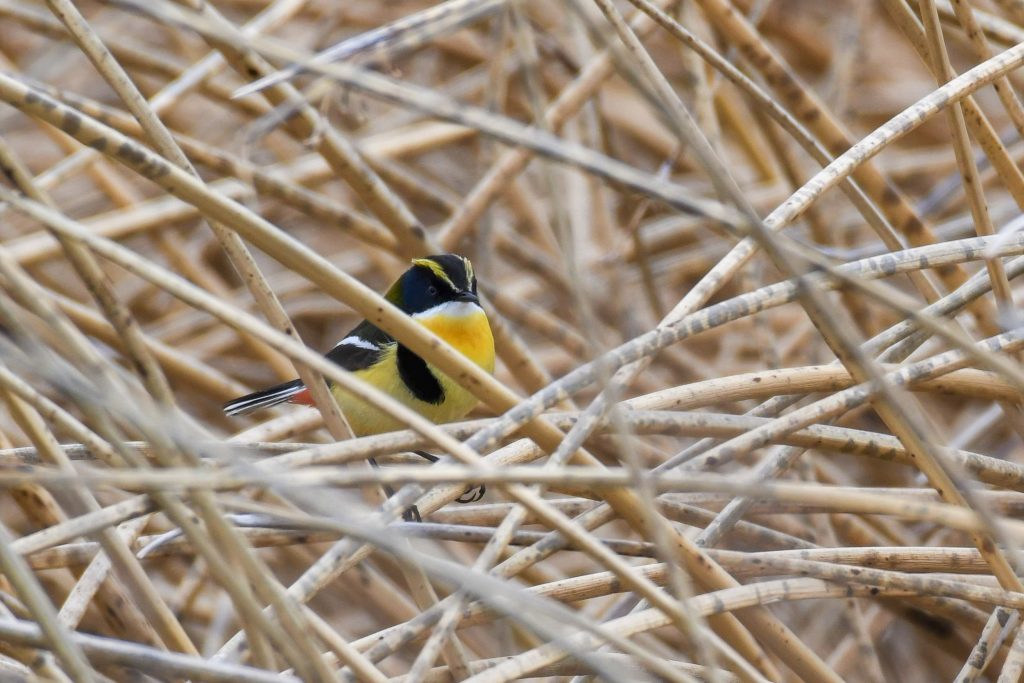
4. Black-browed Albatross

5. Andean Condor

Systematic list
| English | Latin |
| Lesser Rhea | Rhea pennata |
| Darwin’s Nothura | Nothura darwinii |
| Elegant Crested-Tinamou | Eudromia elegans |
| Southern Screamer | Chauna torquata |
| White-faced Whistling-Duck | Dendrocygna viduata |
| Fulvous Whistling-Duck | Dendrocygna bicolor |
| Black-necked Swan | Cygnus melancoryphus |
| Coscoroba Swan | Coscoroba coscoroba |
| Upland Goose | Chloephaga picta |
| Kelp Goose | Chloephaga hybrida |
| Ashy-headed Goose | Chloephaga poliocephala |
| Flying Steamer-Duck | Tachyeres patachonicus |
| Flightless Steamer-Duck | Tachyeres pteneres |
| White-headed/Chubut Steamer-Duck | Tachyeres leucocephalus |
| Crested Duck | Lophonetta specularioides |
| Spectacled Duck | Speculanas specularis |
| Ringed Teal | Callonetta leucophrys |
| Brazilian Teal/Duck | Amazonetta brasiliensis |
| Silver Teal | Spatula versicolor |
| Cinnamon Teal | Spatula cyanoptera |
| Red Shoveler | Spatula platalea |
| Chiloe/Southern Wigeon | Mareca sibilatrix |
| Mallard | Anas platyrhynchos |
| Yellow-billed Pintail | Anas georgica |
| Yellow-billed/Speckled Teal | Anas flavirostris |
| Rosy-billed Pochard | Netta peposaca |
| Black-headed Duck | Heteronetta atricapilla |
| Masked Duck | Nomonyx dominicus |
| Andean Duck | Oxyura ferruginea |
| Lake Duck | Oxyura vittata |
| Dusky-legged Guan | Penelope obscura |
| Chilean Flamingo | Phoenicopterus chilensis |
| White-tufted Grebe | Rollandia rolland |
| Pied-billed Grebe | Podilymbus podiceps |
| Great Grebe | Podiceps major |
| Silvery Grebe | Podiceps occipitalis |
| Rock Pigeon | Columba livia |
| Picazuro Pigeon | Patagioenas picazuro |
| Spot-winged Pigeon | Patagioenas maculosa |
| Picui Ground-Dove | Columbina picui |
| White-tipped Dove | Leptotila verreauxi |
| Eared Dove | Zenaida auriculata |
| Guira Cuckoo | Guira guira |
| Dark-billed Cuckoo | Coccyzus melacoryphus |
| Glittering-bellied Emerald | Chlorostilbon lucidus |
| Gilded Hummingbird | Hylocharis chrysura |
| Austral Rail | Rallus antarcticus |
| Spotted Rail | Pardirallus maculatus |
| Plumbeous Rail | Pardirallus sanguinolentus |
| Giant Wood-Rail | Aramides ypecaha |
| Spot-flanked Gallinule | Porphyriops melanops |
| Common Gallinule | Gallinula galeata |
| Red-fronted Coot | Fulica rufifrons |
| Red-gartered Coot | Fulica armillata |
| White-winged Coot | Fulica leucoptera |
| Rufous-sided Crake | Laterallus melanophaius |
| Limpkin | Aramus guarauna |
| Snowy Sheathbill | Chionis albus |
| Magellanic Plover | Pluvianellus socialis |
| Black-necked Stilt | Himantopus mexicanus |
| American Oystercatcher | Haematopus palliatus |
| Blackish Oystercatcher | Haematopus ater |
| Magellanic Oystercatcher | Haematopus leucopodus |
| Tawny-throated Dotterel | Oreopholus ruficollis |
| Southern Lapwing | Vanellus chilensis |
| Two-banded Plover | Charadrius falklandicus |
| Least Seedsnipe | Thinocorus rumicivorus |
| Wattled Jacana | Jacana jacana |
| Upland Sandpiper | Bartramia longicauda |
| Sanderling | Calidris alba |
| Baird’s Sandpiper | Calidris bairdii |
| White-rumped Sandpiper | Calidris fuscicollis |
| Pectoral Sandpiper | Calidris melanotos |
| South American Snipe | Gallinago paraguaiae |
| Greater Yellowlegs | Tringa melanoleuca |
| Lesser Yellowlegs | Tringa flavipes |
| Chilean Skua | Stercorarius chilensis |
| Brown Skua | Stercorarius antarcticus |
| Brown-hooded Gull | Chroicocephalus maculipennis |
| Gray-hooded Gull | Chroicocephalus cirrocephalus |
| Dolphin Gull | Leucophaeus scoresbii |
| Olrog’s Gull | Larus atlanticus |
| Kelp Gull | Larus dominicanus |
| South American Tern | Sterna hirundinacea |
| Snowy-crowned Tern | Sterna trudeaui |
| Royal Tern | Thalasseus maximus |
| Sandwich Tern | Thalasseus sandvicensis |
| Gentoo Penguin | Pygoscelis papua |
| Magellanic Penguin | Spheniscus magellanicus |
| Black-browed Albatross | Thalassarche melanophris |
| Southern Giant-Petrel | Macronectes giganteus |
| Northern Hall’s Giant-Petrel | Macronectes halli |
| White-chinned Petrel | Procellaria aequinoctialis |
| Magellanic Diving-Petrel | Pelecanoides magellani |
| Maguari Stork | Ciconia maguari |
| Wood Stork | Mycteria americana |
| Anhinga | Anhinga anhinga |
| Neotropic Cormorant | Phalacrocorax brasilianus |
| Magellanic/Rock Cormorant | Phalacrocorax magellanicus |
| Imperial/Blue-eyed Cormorant | Phalacrocorax atriceps |
| Rufescent Tiger-Heron | Tigrisoma lineatum |
| Cocoi Heron | Ardea cocoi |
| Great Egret | Ardea alba |
| Snowy Egret | Egretta thula |
| Cattle Egret | Bubulcus ibis |
| Striated Heron | Butorides striata |
| Whistling Heron | Syrigma sibilatrix |
| Black-crowned Night-Heron | Nycticorax nycticorax |
| White-faced Ibis | Plegadis chihi |
| Bare-faced Ibis | Phimosus infuscatus |
| Black-faced Ibis | Theristicus melanopis |
| Roseate Spoonbill | Platalea ajaja |
| Andean Condor | Vultur gryphus |
| Turkey Vulture | Cathartes aura |
| White-tailed Kite | Elanus leucurus |
| Snail Kite | Rostrhamus sociabilis |
| Long-winged Harrier | Circus buffoni |
| Cinereous Harrier | Circus cinereus |
| Bicolored Hawk | Accipiter bicolor |
| Savanna Hawk | Buteogallus meridionalis |
| Roadside Hawk | Rupornis magnirostris |
| Harris’s Hawk | Parabuteo unicinctus |
| White-tailed Hawk | Geranoaetus albicaudatus |
| Variable Hawk | Geranoaetus polyosoma |
| Black-chested Buzzard-Eagle | Geranoaetus melanoleucus |
| Austral Pygmy-Owl | Glaucidium nana |
| Burrowing Owl | Athene cunicularia |
| Rufous-legged Owl | Strix rufipes |
| Ringed Kingfisher | Megaceryle torquata |
| White Woodpecker | Melanerpes candidus |
| White-fronted Woodpecker | Melanerpes cactorum |
| Checkered Woodpecker | Dryobates mixtus |
| Magellanic Woodpecker | Campephilus magellanicus |
| Green-barred Woodpecker | Colaptes melanochloros |
| Chilean Flicker | Colaptes pitius |
| Campo Flicker | Colaptes campestris |
| White-throated Caracara | Phalcoboenus albogularis |
| Southern Caracara | Caracara plancus |
| Chimango Caracara | Milvago chimango |
| American Kestrel | Falco sparverius |
| Aplomado Falcon | Falco femoralis |
| Peregrine Falcon | Falco peregrinus |
| Monk Parakeet | Myiopsitta monachus |
| Maroon-bellied Parakeet | Pyrrhura frontalis |
| Austral Parakeet | Enicognathus ferrugineus |
| Burrowing Parakeet | Cyanoliseus patagonus |
| Nanday Parakeet | Aratinga nenday |
| Magellanic/Andean Tapaculo | Scytalopus magellanicus |
| Common Miner | Geositta cunicularia |
| Scimitar-billed Woodcreeper | Drymornis bridgesii |
| Narrow-billed Woodcreeper | Lepidocolaptes angustirostris |
| White-throated Treerunner | Pygarrhichas albogularis |
| Straight-billed Earthcreeper | Ochetorhynchus ruficaudus |
| Band-tailed Earthcreeper | Ochetorhynchus phoenicurus |
| Rufous Hornero | Furnarius rufus |
| Wren-like Rushbird | Phleocryptes melanops |
| Scale-throated Earthcreeper | Upucerthia dumetaria |
| Buff-winged Cinclodes | Cinclodes fuscus |
| Blackish Cinclodes | Cinclodes antarcticus |
| Gray-flanked Cinclodes | Cinclodes oustaleti |
| Dark-bellied Cinclodes | Cinclodes patagonicus |
| Thorn-tailed Rayadito | Aphrastura spinicauda |
| Tufted Tit-Spinetail | Leptasthenura platensis |
| Plain-mantled Tit-Spinetail | Leptasthenura aegithaloides |
| Freckle-breasted Thornbird | Phacellodomus striaticollis |
| Short-billed Canastero | Asthenes baeri |
| Sharp-billed Canastero | Asthenes pyrrholeuca |
| Straight-billed Reedhaunter | Limnoctites rectirostris |
| Patagonian Canastero | Pseudasthenes patagonica |
| Bay-capped Wren-Spinetail | Spartonoica maluroides |
| White-throated Cacholote | Pseudoseisura gutturalis |
| Yellow-chinned(throated) Spinetail | Certhiaxis cinnamomeus |
| Chotoy Spinetail | Schoeniophylax phryganophilus |
| Southern Beardless-Tyrannulet | Camptostoma obsoletum |
| Suiriri Flycatcher | Suiriri suiriri |
| Tufted Tit-Tyrant | Anairetes parulus |
| Warbling Doradito | Pseudocolopteryx flaviventris |
| White-crested Elaenia | Elaenia albiceps |
| Small-billed Elaenia | Elaenia parvirostris |
| Sooty Tyrannulet | Serpophaga nigricans |
| White-crested Tyrannulet | Serpophaga subcristata |
| Southern Scrub-Flycatcher | Sublegatus modestus |
| Many-colored Rush Tyrant | Tachuris rubrigastra |
| Greater Wagtail-Tyrant | Stigmatura budytoides |
| Bran-colored Flycatcher | Myiophobus fasciatus |
| Vermilion Flycatcher | Pyrocephalus rubinus |
| Austral /Rufous-backed Negrito | Lessonia rufa |
| White-winged Black-Tyrant | Knipolegus aterrimus |
| Spectacled Tyrant | Hymenops perspicillatus |
| Ochre-naped Ground-Tyrant | Muscisaxicola flavinucha |
| Dark-faced Ground-Tyrant | Muscisaxicola maclovianus |
| White-browed Ground-Tyrant | Muscisaxicola albilora |
| Black-billed Shrike-Tyrant | Agriornis montanus |
| Great Shrike-Tyrant | Agriornis lividus |
| Gray-bellied Shrike-Tyrant | Agriornis micropterus |
| Lesser Shrike-Tyrant | Agriornis murinus |
| Fire-eyed Diucon | Xolmis pyrope |
| Black-crowned Monjita | Xolmis coronatus |
| Rusty-backed Monjita | Xolmis rubetra |
| Chocolate-vented Tyrant | Neoxolmis rufiventris |
| Black-backed Water-Tyrant | Fluvicola albiventer |
| Patagonian Tyrant | Colorhamphus parvirostris |
| Cattle Tyrant | Machetornis rixosa |
| Swainson’s Flycatcher | Myiarchus swainsoni |
| Great Kiskadee | Pitangus sulphuratus |
| Streaked Flycatcher | Myiodynastes maculatus |
| Tropical Kingbird | Tyrannus melancholicus |
| Fork-tailed Flycatcher | Tyrannus savana |
| White-tipped Plantcutter | Phytotoma rutila |
| Rufous-tailed Plantcutter | Phytotoma rara |
| Chivi Vireo | Vireo chivi |
| Blue-and-white Swallow | Pygochelidon cyanoleuca |
| Tawny-headed Swallow | Alopochelidon fucata |
| Southern Martin | Progne elegans |
| Brown-chested Martin | Progne tapera |
| White-rumped Swallow | Tachycineta leucorrhoa |
| Chilean Swallow | Tachycineta leucopyga |
| Barn Swallow | Hirundo rustica |
| House Wren | Troglodytes aedon |
| Sedge / Grass Wren | Cistothorus platensis |
| Masked Gnatcatcher | Polioptila dumicola |
| Rufous-bellied Thrush | Turdus rufiventris |
| Austral Thrush | Turdus falcklandii |
| Creamy-bellied Thrush | Turdus amaurochalinus |
| Chiguanco Thrush | Turdus chiguanco |
| Patagonian Mockingbird | Mimus patagonicus |
| Chalk-browed Mockingbird | Mimus saturninus |
| White-banded Mockingbird | Mimus triurus |
| European Starling | Sturnus vulgaris |
| Yellowish Pipit | Anthus lutescens |
| Correndera Pipit | Anthus correndera |
| Hellmayr’s Pipit | Anthus hellmayri |
| European Goldfinch | Carduelis carduelis |
| Hooded Siskin | Spinus magellanicus |
| Black-chinned Siskin | Spinus barbatus |
| Rufous-collared Sparrow | Zonotrichia capensis |
| White-browed Meadowlark | Leistes superciliaris |
| Long-tailed Meadowlark | Leistes loyca |
| Solitary Black Cacique | Cacicus solitarius |
| Screaming Cowbird | Molothrus rufoaxillaris |
| Shiny Cowbird | Molothrus bonariensis |
| Austral Blackbird | Curaeus curaeus |
| Scarlet-headed Blackbird | Amblyramphus holosericeus |
| Chopi Blackbird | Gnorimopsar chopi |
| Grayish Baywing | Agelaioides badius |
| Yellow-winged Blackbird | Agelasticus thilius |
| Chestnut-capped Blackbird | Chrysomus ruficapillus |
| Brown-and-yellow Marshbird | Pseudoleistes virescens |
| Masked Yellowthroat | Geothlypis aequinoctialis |
| Tropical Parula | Setophaga pitiayumi |
| Golden-crowned Warbler | Basileuterus culicivorus |
| Red-crested Cardinal | Paroaria coronata |
| Yellow-billed Cardinal | Paroaria capitata |
| Black-capped Warbling-Finch | Microspingus melanoleucus |
| White-lined Tanager | Tachyphonus rufus |
| Blue-and-yellow Tanager | Pipraeidea bonariensis |
| Sayaca Tanager | Thraupis sayaca |
| Chestnut-backed Tanager | Tangara preciosa |
| Gray-hooded Sierra-Finch | Phrygilus gayi |
| Patagonian Sierra-Finch | Phrygilus patagonicus |
| Mourning Sierra-Finch | Phrygilus fruticeti |
| Carbonated Sierra-Finch | Phrygilus carbonarius |
| Common Diuca-Finch | Diuca diuca |
| Yellow-bridled Finch | Melanodera xanthogramma |
| Plumbeous Sierra-Finch | Geospizopsis unicolor |
| Long-tailed Reed Finch | Donacospiza albifrons |
| Black-and-rufous Warbling-Finch | Poospiza nigrorufa |
| Patagonian Yellow-Finch | Sicalis lebruni |
| Saffron Finch | Sicalis flaveola |
| Grassland Yellow-Finch | Sicalis luteola |
| Great Pampa-Finch | Embernagra platensis |
| Double-collared Seedeater | Sporophila caerulescens |
| Grayish Saltator | Saltator coerulescens |
| Golden-billed Saltator | Saltator aurantiirostris |
| House Sparrow | Passer domesticus |
